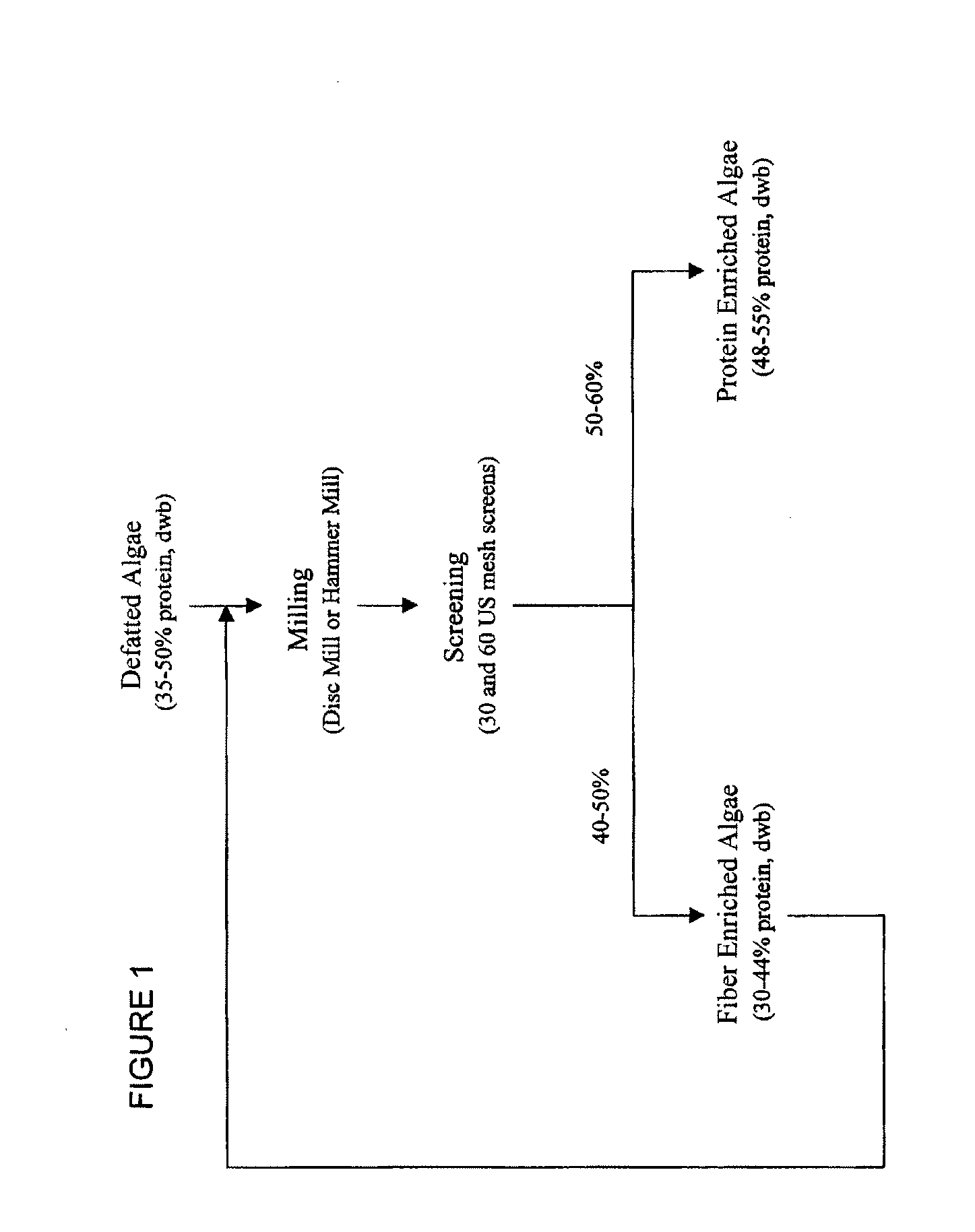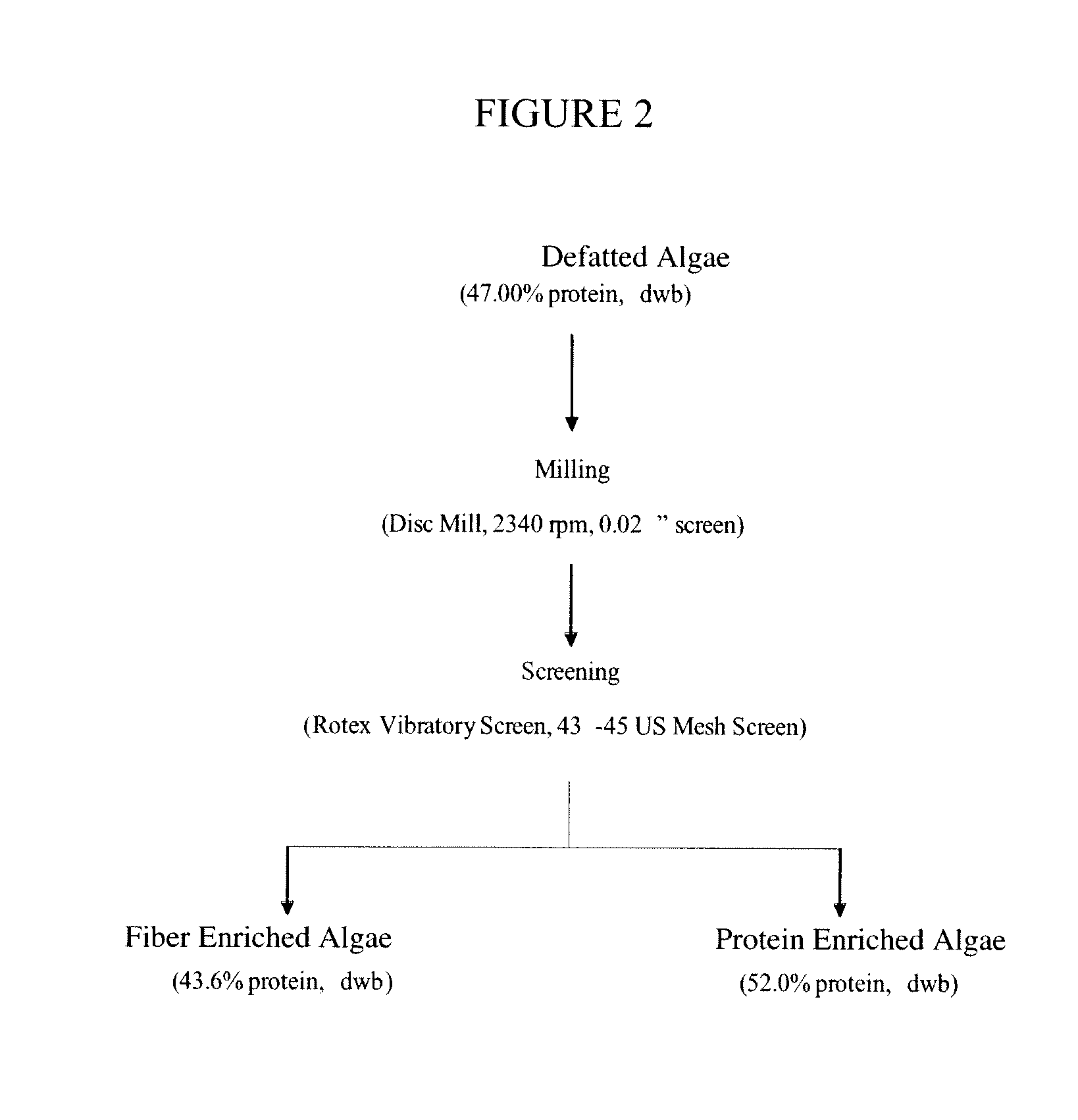Protein concentrates and isolates, and processes for the production thereof from macroalgae and/or microalgae
- Summary
- Abstract
- Description
- Claims
- Application Information
AI Technical Summary
Benefits of technology
Problems solved by technology
Method used
Image
Examples
example 1
Prophetic Preparation of Protein Concentrate Using Phytase from Algae
[0858]Approximately 15 kg dried microalgae or macroalgae is mixed with 120 kg of tab water at ambient temperature. Approximately 12 g of phytase (Natuphos 10,000 L Phytase) at 0.08% dosage based on the starting weight of dried microalgae or macroalgae is added to the slurry. The pH of algae slurry is adjusted to 5.5 and temperature to 50° C. After holding for 1.5 hours under agitation, the slurry is centrifuged at 180 g force (1500 RPM bowl speed) to separate fiber solids from algae protein slurry (slurry 1) containing soluble and insoluble proteins using a Bird Decanter (Bird 6″ Continuous Bowl Decanter, Saskatoon, Canada). Fiber solids is mixed with water at a ratio of 1 to 1 by weight at ambient temperature, which is followed by centrifugation at 180 g force (1500 RPM bowl speed) to separate the 1st washed fiber solids from the protein slurry (slurry 2) containing soluble and insoluble proteins using the Bird De...
example 2
Prophetic Preparation of Protein Concentrate Using Phytase from Algae
[0860]Approximately 40 kg of dried microalgae or macroalgae is mixed with 320 kg of tab water at ambient temperature. Approximately 32 g of phytase (Natuphos 10,000 L Phytase) at 0.08% dosage based on the starting weight of algae is added to the algae slurry. The pH of algae slurry is adjusted to 5.5 and temperature to 50° C. After holding for 1.5 hours under agitation, the algae slurry is centrifuged at 180 g force (1500 RPM bowl speed) to separate fiber solids from algae protein slurry (slurry 1) containing soluble and insoluble proteins using the Bird Decanter (Bird 6″ Continuous Bowl Decanter, Saskatoon, Canada). Fiber solids are mixed with water at a ratio of 1 to 1 by weight at ambient temperature, which is followed by centrifugation at 180 g force (1500 RPM bowl speed) to separate the washed fiber solids from the algae protein slurry (slurry 2) containing soluble and insoluble proteins using the Bird Decante...
example 3
Preparation of Protein Concentrate from Microalage
(i) Without Protein Hydrolysis—Control
[0863]Approximately 0.5 kg of defatted microalgae (Chlorella) was mixed with 0.5 kg of water at ambient temperature. pH of the microalgae slurry was at 5.76. The slurry was heated to 50° C. Approximately 0.075 g of phytase (Natuphos, 55,000 FTU / g) was added to the slurry. The slurry was held at 50° C. for 1 hour under agitation. pH of the slurry was adjusted to 7.0 by addition of 10% NaOH solution. This was followed by centrifugation at 4,000 rpm for 10 minutes to separate the soluble extract from the insoluble solids using a lab centrifuge. The insoluble solids were washed with water twice. For each wash, the insoluble solids were mixed with water at a ratio of 1 to 2 by weight, which was followed by centrifugation at 4,000 rpm for 10 minutes to separate the washed insoluble solids from the washing extract. The washed solids were freeze dried into protein concentrate. The soluble extract was com...
PUM
| Property | Measurement | Unit |
|---|---|---|
| Temperature | aaaaa | aaaaa |
| Temperature | aaaaa | aaaaa |
| Fraction | aaaaa | aaaaa |
Abstract
Description
Claims
Application Information
 Login to View More
Login to View More - R&D
- Intellectual Property
- Life Sciences
- Materials
- Tech Scout
- Unparalleled Data Quality
- Higher Quality Content
- 60% Fewer Hallucinations
Browse by: Latest US Patents, China's latest patents, Technical Efficacy Thesaurus, Application Domain, Technology Topic, Popular Technical Reports.
© 2025 PatSnap. All rights reserved.Legal|Privacy policy|Modern Slavery Act Transparency Statement|Sitemap|About US| Contact US: help@patsnap.com



